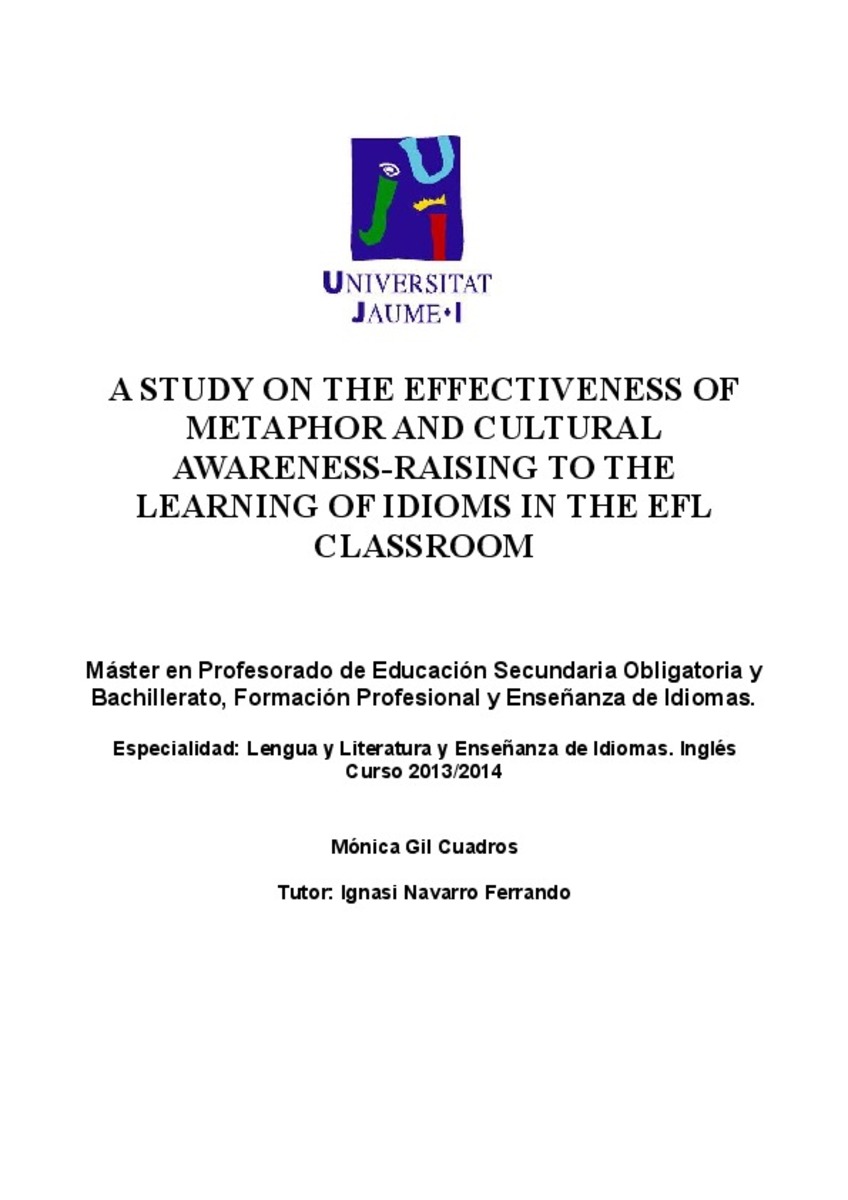Mostrar el registro sencillo del ítem
A study on the effectiviness of metaphor and cultural awareness-raising to the learning of idioms in the EFL classroom
| dc.contributor | Navarro i Ferrando, Ignasi | |
| dc.contributor | Universitat Jaume I. Departament d'Estudis Anglesos | |
| dc.contributor.author | Gil Cuadros, Mónica | |
| dc.date.accessioned | 2014-11-14T12:56:20Z | |
| dc.date.available | 2014-11-14T12:56:20Z | |
| dc.date.issued | 2014-07-22 | |
| dc.identifier.uri | http://hdl.handle.net/10234/108240 | |
| dc.description | Treball Final del Màster Universitari en Professor/a d'Educació Secundària Obligatòria i Batxillerat, Formació Professional i Ensenyaments d'Idiomes. Codi: SAP419. Curs acadèmic 2013-2014 | ca_CA |
| dc.description.abstract | Idioms are one of the most fascinating and complex aspects of the language, since they contain a great deal of the TL culture and native speakers' way of perceiving reality. However their figurative nature makes that most EFL students have problems when learning and acquiring them. This situation together with the traditional method employed to teach idioms, which is based on the structural view of language, and that employs drills and repetitive activities in order to memorise idioms, makes that IEs represent a nightmare for students. Taking into account these problems, the objective of this study is to adopt the cognitive view of language to design a methodology to teach idioms in the EFL classroom. The aim of this methodology is to raise students awareness of the metaphors and cultural implications that are behind most idioms in English, in order to facilitate their learning. Moreover, this study also considers students' learning differences, such as level of motivation and learning styles. For that reason, the methodology presented is carried out in two different classrooms in which different levels of motivation and different learning styles are observed. The results of the metaphor and cultural awareness-raising methodology (experimental groups) are compared to those obtained following a traditional methodology (control groups) in order to test the effectivity of the lesson plan presented. Results suggest that the learning differences observed between the two groups are relevant, since they affect the degree of efficiency of the methodology, concluding that the metaphor and cultural awareness-raising methodology is more effective in a group of students with low level of motivation and with preference for a visual learning style. | ca_CA |
| dc.format.extent | 59 p. | ca_CA |
| dc.format.mimetype | application/pdf | ca_CA |
| dc.language.iso | eng | ca_CA |
| dc.publisher | Universitat Jaume I | ca_CA |
| dc.rights | Attribution-NonCommercial-ShareAlike 4.0 Spain | * |
| dc.rights.uri | http://creativecommons.org/licenses/by-nc-sa/4.0/ | * |
| dc.subject | Màster Universitari en Professor/a d'Educació Secundària Obligatòria i Batxillerat, Formació Professional i Ensenyaments d'Idiomes | ca_CA |
| dc.subject | Máster Universitario en Profesor/a de Educación Secundaria Obligatoria y Bachillerato, Formación Profesional y Enseñanzas de Idiomas | ca_CA |
| dc.subject | Master's Degree in Secondary Education, Vocational Training and Language Teaching | ca_CA |
| dc.subject | Idioms | ca_CA |
| dc.subject | Idiomatic expressions | ca_CA |
| dc.subject | Structuralism | ca_CA |
| dc.subject | Cognitivism | ca_CA |
| dc.subject | Metaphor | ca_CA |
| dc.subject | Cultural awareness-raising | ca_CA |
| dc.title | A study on the effectiviness of metaphor and cultural awareness-raising to the learning of idioms in the EFL classroom | ca_CA |
| dc.type | info:eu-repo/semantics/masterThesis | ca_CA |
| dc.educationLevel | Estudios de Postgrado | ca_CA |
| dc.rights.accessRights | info:eu-repo/semantics/openAccess | ca_CA |
Ficheros en el ítem
Este ítem aparece en la(s) siguiente(s) colección(ones)
-
TFM: Màster Universitari en Professor/a d'Educació Secundària Obligatòria i Batxillerat, Formació Professional i Ensenyaments d'Idiomes [1230]
SAP118, SAP119, SAP128, SAP129, SAP138, SAP139, SAP218, SAP219, SAP228,SAP229, SAP238, SAP239, SAP319, SAP419, SAP429, SAP509, SAP909, SAP709, SAP809








